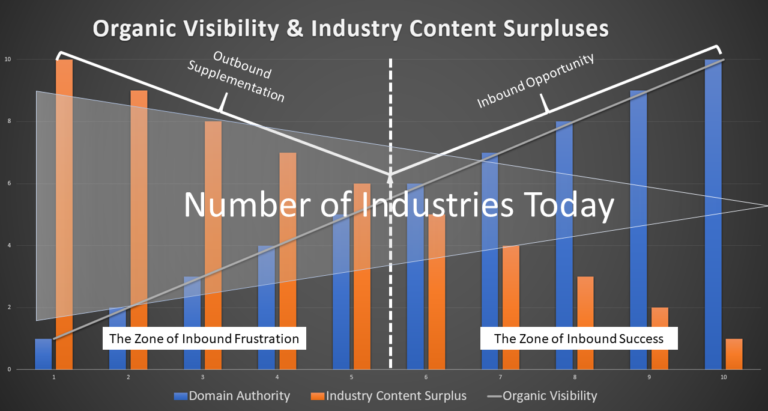Did you send an email today? Congratulations you’ve just added another digit onto the other 200,000,000,000 odd emails that typically clog up our collective inboxes daily. (For those not mathematically inclined, that’s billions, not millions.) There have been almost 3 million blogs published so far today, and it’s still morning as I write. Since the beginning of this particular sentence, another 12,000 tweets, give or take, have just been birthed and flown the coop.
You get the idea; for those of you in the B2B content marketing game, there is a lot of content out there. An unimaginably massive mother load, actually. And it’s all in direct competition with your latest published article or infographic. You v. Billions. You might want to read on…
My content is drowning in a tsunami of crap! HELP!!!
The law of supply and demand rules our capitalistic world. B2B inbound marketing is no exception. As the intro emphasised, there is far more content being created than can ever be consumed. For your content to get noticed, somebody else’s must gather dust. If it’s not trending, it’s tumbleweed.
We've blogged previously on how to find a content sweetspot to create content that your buyers are interested in, targeting keywords that are not being covered by your competition on subjects that you are an authority on. However many B2B companies really struggle here to stand out.
I came across a recent article from Chad Pollitt from Relevence who propositions the content surplus and deficit markets. I pulled the following graph from Chad's article.

As we can see, getting noticed is a challenge, as there are ever decreasing organic returns on inbound marketing in markets saturated with content i.e. most markets today. Nowhere quite matches the content surplus market than the content marketing world, so if you’re reading this, I’ve done something right, right?
Are content deficit markets unicorns?
Even if you’re lucky enough to be in that tiny minority who plough the content deficit fields, the personas you target aren’t. They’re going to be bombarded with content from all angles for every one of their well documented pain points - so while you might be lucky enough to be first to market with content for your particular niche, you are still just another dot on the horizon. Content strategies can then appear to fall somewhere in between damned if you do and damned if you don’t.
So is inbound marketing a scam?
No. It’s really not. B2B inbound marketing isn’t a silver bullet - but it is still your best shot. Ideally it should be used in combination, rather than in competition, with other marketing initiatives (in the short term especially.) In the long run, it’s still the ideal framework for most B2B marketers. It’s still the most cost effective and efficient digital marketing tool at your disposal. There will never be a more valuable, sales call than one initiated by your sweet spot target out of the blue.
If Carlsberg did B2B, they’d do Inbound. But these days, it’s just going to be a much more difficult challenge than Hubspot might suggest on their upbeat sales calls. If you find yourself asking "why isn't inbound marketing working for me?" there could be many areas where you've dropped the ball without even realising it. We're just covering outreach in this article. What OUTREACH strategies work best for B2B companies?
Basically, the ones that compliment, rather than compete. Mix a little paid into your earned and free pots. A little cash injection to boost visibility in the short term never hurts to give legs to valuable new content. (And ensure your content is always built with long shelf life durability in mind. It needs to gain value in time rather than depreciate.)
Never underestimate the importance of using content to earn backlinks. The more backlinks a page garners over time the more valuable the real estate and the higher it performs on Google search results for the associated keywords. None of us know the exact algorithms running Google. But we do know that Google understands, validates and prioritises all web pages through the number and quality of their linked profiles. A good backlink strategy is a well signposted beacon for the bots.
“So how do I earn quality inbound backlinks to rise up Google search results?” you might ask. With great content and great promotion is one answer. And with great difficulty and perseverance is the other. (But you’re in this for the long run, right?)
Earned media opportunities for B2B content promotion
Earned media is the honey pot you’re after for content promotion. The idea is to get your content out there through relationship building with influencers, editors, journalists, bloggers, peers, publications and whoever/whatever else. There are some tools that can help you, but a lot of digital elbow grease will be required nonetheless.
Monitor backlink performance. Be wary of any agencies who sell backlinks directly. You can’t automate relationships. So if you’re buying links in bulk, you’re cheating, the links are dodgy and the bots will find you and punish you. It’s just a matter of time. You can’t game the system anymore. You’ll have to dog it out or partner up with someone who can help fast track the introductions. If you're looking for an app that monitors backlinks for you, then these guys at LinkOkay are worth checking out. With the right contacts built over time you can earn the right to get your content featured across news publications, guest blogs, syndication networks and editorial content on relevant trade media and big publisher sites.
How to get big publications to feature your niche B2B content
Study the native content that regularly features on these target publications. What do they talk about, what stance do they take, what formats do they feature and reach out to them with content features that you think might interest them. Let this research inform the content you plan to create. Rather than creating your content first with blinkers on and outreaching in the hope that it will get published. Instead find a middle ground between the type of content that can help promote some aspect of your business and the type of content that gets featured on your target publications.
Let’s say you manufacture ball bearings and you want to ramp up awareness. You might ask yourself, why would Forbes be interested in an article about ball bearings? Well, ball bearings are used to make pens. With smartphones and word processors replacing pens as the medium of choice that documents life, perhaps handwriting or calligraphy is becoming a dying art? Is long copy being replaced by visuals in today’s digital communication era? Is the popularity of social media, allied to ever shorter attention spans, placing increasing emphasis on short, visually led content at the expense of penmanship? Is the written word (analogy or digital) itself at risk? All of a sudden you have the makings of an interesting human interest article, or a writing competition or infographic that Forbes might indeed publish and your ball bearing manufacturing company might just earn a valuable backlink from a high domain authority site.
Point being there are no easy answers or quick fixes here, but there are solutions. There is a lot of research, planning and strategy required upfront before you create anything. There is a constant need to outreach, initiate and develop relationships with influencers, journalists, and editors. Over time this will pay dividends as more and more of the content you produce, will be ready made for the publications of your choosing and you will find even more opportunities to get your content reaching bigger and bigger audiences and earning valuable backlinks all the time.









